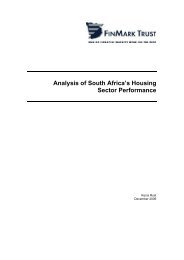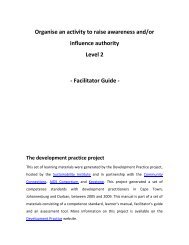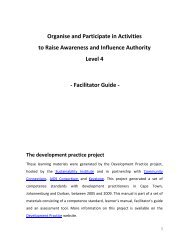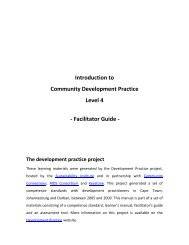the struggle for integrated sustainable settlements.
the struggle for integrated sustainable settlements.
the struggle for integrated sustainable settlements.
Create successful ePaper yourself
Turn your PDF publications into a flip-book with our unique Google optimized e-Paper software.
Any settlement development or upgrading plan should include not only short-term physical and economic<br />
objectives, but long-term social, environmental and economic development goals that are agreed by all<br />
stakeholders in <strong>the</strong> particular context. According to Loots and Irurah (2005),<br />
“… <strong>the</strong> absence of tools and mechanisms which systematically link sustainability criteria, targets and<br />
assessment outcomes with decision-making processes signifi cantly inhibits <strong>the</strong> trans<strong>for</strong>mation from<br />
conventional to sustainability practice in <strong>the</strong> built environment.”<br />
BREAKING NEW GROUND<br />
Though <strong>the</strong>re are many challenges in rolling out <strong>integrated</strong>, ecological developments, things are<br />
beginning to change. In September, 2004, <strong>the</strong> National Department of Housing launched its new housing<br />
policy, Breaking New Ground (BNG), which aims to dramatically change <strong>the</strong> status quo.<br />
BNG introduces a radical shift from <strong>the</strong> ‘quantity over quality’ mindset entrenched in subsidised housing<br />
delivery and points to participative, multi-dimensional approaches which enable people to become<br />
participants in creating <strong>sustainable</strong> human <strong>settlements</strong>, ra<strong>the</strong>r than being mere recipients of an RDP house<br />
(NDOH. 2004). Multiple funding mechanisms have also been introduced which enable <strong>the</strong> purchase of land,<br />
<strong>the</strong> roll out of infrastructure, varied housing fi nance options, housing typologies, and social facilities <strong>for</strong><br />
vulnerable communities.<br />
O<strong>the</strong>r national and local responses to <strong>the</strong> need <strong>for</strong> <strong>the</strong> more <strong>sustainable</strong> design and<br />
construction of <strong>settlements</strong> include:<br />
• Department of Environmental Affairs and Tourism guidelines promoting sustainability in municipal<br />
<strong>integrated</strong> development planning<br />
• <strong>the</strong> establishment of <strong>the</strong> South African Green Building Council and packed audiences at national green<br />
building conferences<br />
• <strong>the</strong> keen interest in Australian eco-labelling systems <strong>for</strong> building materials, which are being explored <strong>for</strong><br />
adaptation in <strong>the</strong> South African context<br />
• <strong>the</strong> increasing availability of green products, goods and services, and <strong>the</strong>ir promotion in mainstream<br />
media<br />
• increasing numbers of professionals and ordinary citizens interested in <strong>sustainable</strong> alternatives<br />
page 2








